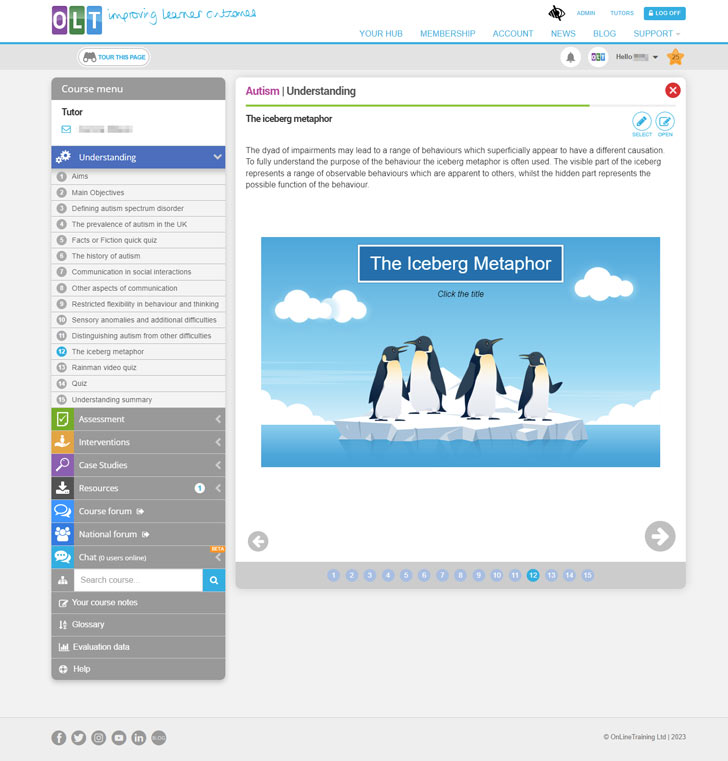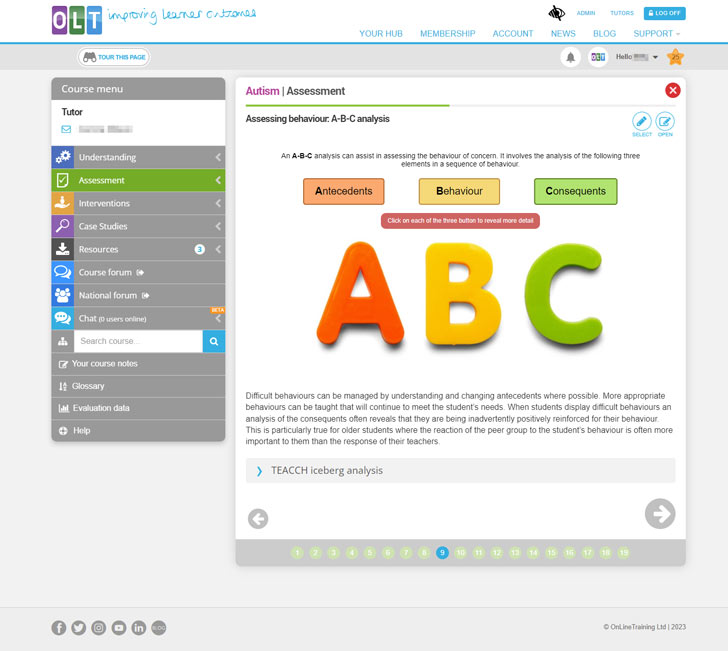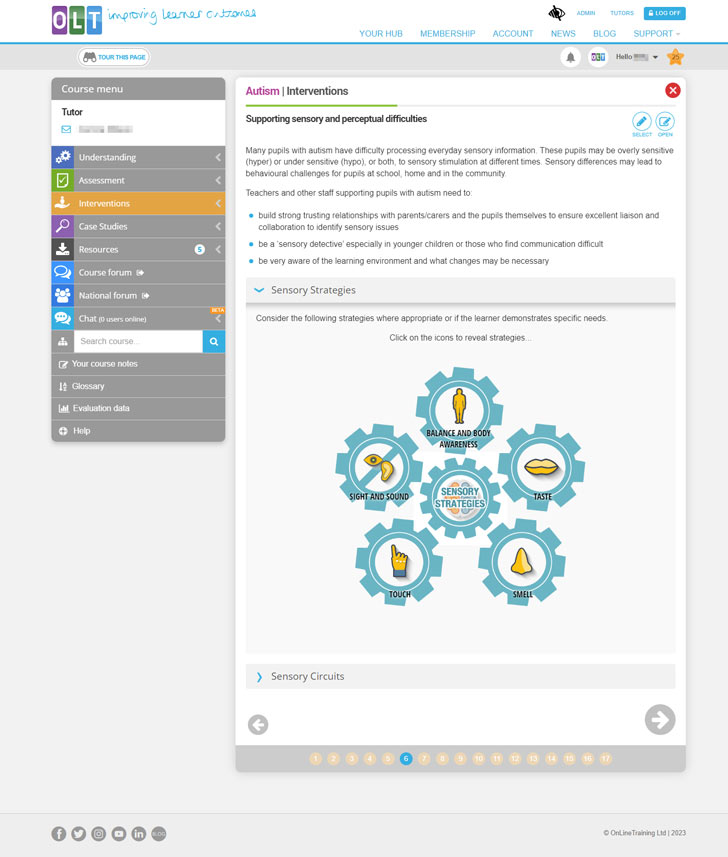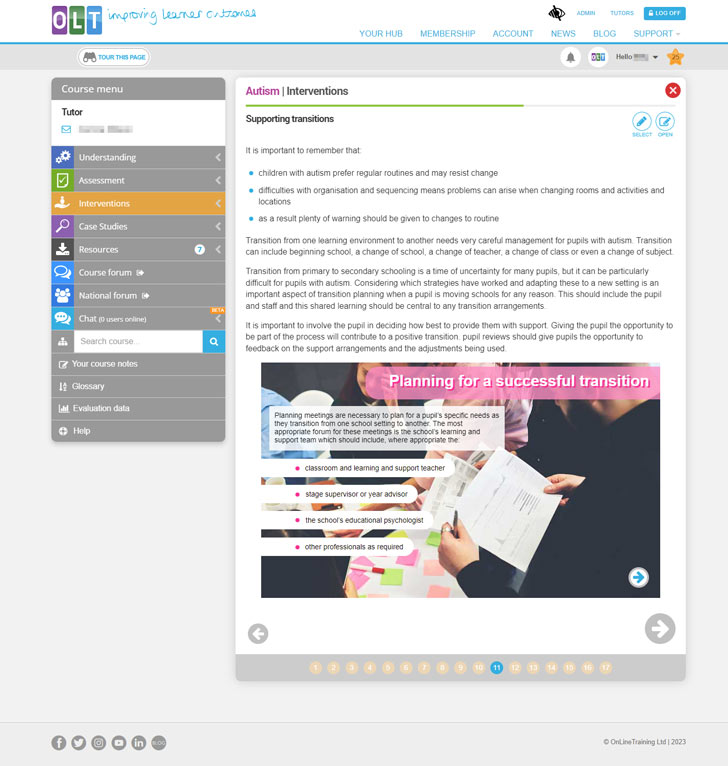Courses Paid courses Autism Spectrum Disorder
Autism Spectrum Disorder
| Achieve a certificate |

Autism is a lifelong neurological and developmental disorder that affects children/young people in different ways. As a spectrum disorder, pupils with autism can have difficulties communicating with and relating to others and display restricted and repetitive interests and behaviours. Building a secure knowledge of how autism presents in girls and boys is critical if schools and teaching staff are to identify how to support their often-exhausting attempts to fit into a neurotypical world.
Educational settings can be a triggering environment for learners with autism. They may be oversensitive to some sounds, sudden movements, certain smells and visual stimuli. They can appear distressed or anxious when routines are changed. They may also show a lack of awareness or insensitivity to other peoples’ feelings or social cues. On this course, you will learn about the impact autism can have on a learner’s life. You will also learn how to make reasonable adjustments to your classroom and teaching practice to have a positive impact on your learner’s achievements, relationships and self-esteem.
This course aims to develop the knowledge, skills and practice of all education professionals working with children and young people (CYP) on the autistic spectrum. You will learn how to assess the needs of a learner and go on to develop a support plan consisting of SMART goals and interventions, which you will implement and later review to determine how well it meets the learner’s specific developmental needs.
This course responds to the information needs of the whole community/team supporting the child/young person with an autism spectrum disorder. Parents and carers benefit from raised awareness of their child’s needs. Advisory teachers, therapists and educational psychologists gain access to evidence-based CPD resources that can be used to strengthen capacity in their local authority and schools. Schools can use this course to train individuals or groups of teachers and teaching support staff as part of a school’s improvement plan or a whole-school initiative. NQTs/RQTs also build a secure knowledge of the graduated approach at the start of their career.
Course learning outcomes
On successful completion of the course, you will be able to:
- describe the distinguishing features of autism spectrum disorders
- explain the restricted flexibility in behaviour and thinking
- identify potential atypical sensory responses to environment stimuli
- explain the purpose and process of individual education assessments
- choose appropriate assessment tools to determine the level of adjustments required
- carry out assessments of communication, social integration and sensory processing abilities
- evaluate particular behaviours and their implications for learning
- design and plan strategies to reinforce desirable behaviour
- devise interventions to develop communication and social skills
- assist your school to develop an ASD-friendly learning environment
- create an action plan to support a pupil/group of pupils in your school
Our courses are structured into four sections. Click on the section headings to reveal page titles and some example content.
Learn about autism spectrum disorder, the distinguishing characteristics, its prevalence, and other behaviours that may arise.
- Course aim
- Section objectives
- Defining autism spectrum disorder
- The prevalence of ASD in the UK
- Quick quiz: Facts or fiction
- The History of ASD
- Communication in social interactions
-
Other aspects of communication

Screenshot from Understanding page 8 - Restricted flexibility in behaviour and thinking
- Sensory anomalies and additional difficulties
- Distinguishing ASD from other difficulties
-
The iceberg metaphor

Screenshot from Understanding page 12 - Video quiz: "Rainman"
- End of section quiz
- Section summary
Understand the need for assessment, and the range of informal assessments that can be carried out in schools.
- The purpose of assessment and your learner’s profile
- The process of assessment
- Assessing communication
-
Assessing social interaction

Screenshot from Assessment page 4 - Assessing social imagination
- Assessing flexibility in behaviour and thought
- Assessing sensory process
- Assessing perceptual differences
-
Assessing behaviour: A-B-C analysis

Screenshot from Assessment page 9 - Assessing behaviour: S.T.A.R analysis
- Identifying antecedents and setting events
- Assessing the physical environment
- Assessing school culture and climate
- Assessing the need for adjustments
- Assessing the predictability of the school environment
- Other factors to consider when assessing needs
- Course assignment: Your learner’s three SMART goals
- End of section quiz
- Section summary
Explore a range of inclusive adjustments to meet the needs of pupils with autism spectrum disorder (ASD) and discover ideas for developing an ASD friendly learning environment.
- Section objectives
- Developing and designing appropriate interventions
- Developing communication skills
- Developing social relationship skills
- Supporting flexible thinking
-
Supporting sensory and perceptual difficulties

Screenshot from Interventions page 6 - Using visual and other prompts
- Managing antecedents
- Reinforcing desirable behaviour
- Developing an ASD friendly learning environment
-
Supporting transitions

Screenshot from Interventions page 11 - Curriculum adjustments in the classroom
- Developing resilience and coping skills
- Developing collaboration between home and school
- Course assignment: Your learner’s interventions
- End of section quiz
- Section summary
View videos of authentic learners with autism, the interventions implemented and their resulting progress.
- Case study: Adam, age 6
- Case study: Lois, age 7
- Case study: Matthew, age 14
- Case Study: Teachers TV
- Case Study: Understanding Christopher
The training has helped me revise my knowledge and understanding of ASC and developed my awareness of appropriate interventions. Exploring SMART goals reminded me of the small steps often required to help students achieve and improved my confidence to discuss these with schools
Other Position (18/08/2021)
Listening and learning from the wonderful learners describing how they feel, how they see, how they learn has been invaluable. Making small changes to enable our learners to have the same opportunity to succeed as their peers. Understanding what we can do as educators to best support our learners with Autism. Understanding it's the environment and communication that needs to be tweaked - reasonable adjustments need to be put into place to enable same access to same information just delivered in a different way. Thinking about how you can teach through visual communication rather than too much talk. This has been a great training tool and I am super pleased I have been able to access. Thank you
Other Position (09/08/2021)
The training has enabled me to have the confidence to see the signs of a child who may have ASD and to pursue any action that will be required to help the children, to be in contact with the SENCO leader and any outside agency's
Teaching Assistant (21/07/2021)
I have improved my understanding of ASD and what difficulties children with autism may have. This has helped me to identify the difference between ASD and other disorders. Moreover, learnt that often children can have ASD and Dyslexia or ASD and ADHD and others. Furthermore, I have learnt many strategies to improve my interventions. This has helped me to set my goals to support my student. I have also learnt the importance of the collaborative partnership between the parents and the school
Other Position (14/05/2021)
This course has definitely improved my understanding of autistic spectrum disorder. I am applying all my new knowledge in my role as a SEND Assistant. This course has developed my understanding of meet the needs of the children I work with, the appropriate assessment tools to use and effective strategies that can be used. I really appreciate the opportunity to have taken part in this course.
Teaching Assistant (13/05/2021)
I think this course was useful for me as I am working with an autistic pupil this year. It will help me to understand her needs better and to use appropriate techniques to support her on her way to success
Teaching Assistant (10/05/2021)
I am very thoughtful when assisting in a lesson with information I have received during this course
Teaching Assistant (29/04/2021)
I think this training has given me a very good insight of how to effectively support children with ASD and meet their needs. In class I feel like I am picking up on a lot more ASD traits in students as well which also helps me to support in the classroom.
Teaching Assistant (21/04/2021)
I thought the last video was very clear and this gave more knowledge of how a person with ASD felt from his young years to reaching adulthood. With this knowledge I feel more confident in understanding how a child may react to certain secondary classroom /subjects. this will give me the confidence to implement appropriate strategies when supporting students with ASD.
Teaching Assistant (21/04/2021)
| Rating |
| |
Delivery
|
| |
20 hours, 1-2 hrs per week |
| |
Flexible start date |
| |
Assignment
|
Licences
Your school or education system can purchase a licence to deliver our courses.
Contact us to find out moreCertification
20 hrs CPD Certified What's this?
Certificate of Achievement

